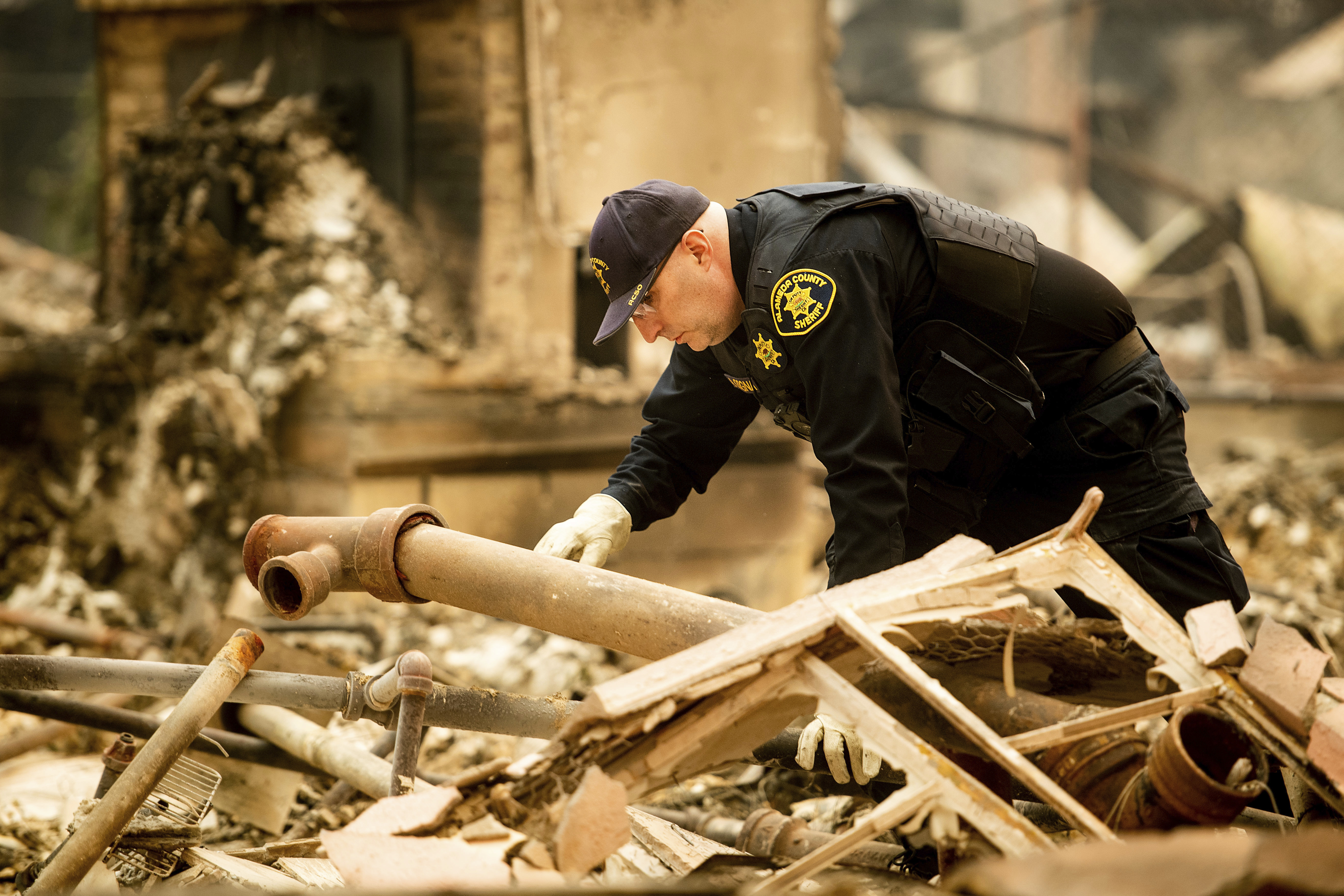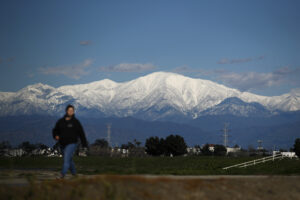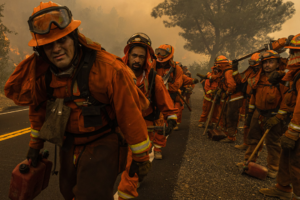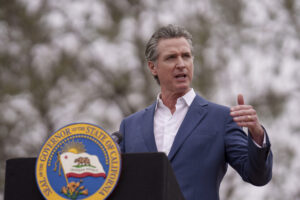The Death Toll of California’s Historic Wildfire Continues to Climb
The count in Northern California rises to a record 42 as authorities search burned-out cars and homes. Alameda County Sheriff's Deputy A. Gogna searches for victims of the Camp Fire earlier this week. (Noah Berger / AP)
Alameda County Sheriff's Deputy A. Gogna searches for victims of the Camp Fire earlier this week. (Noah Berger / AP)
Truthdig update: The death toll in the Camp Fire in Northern California is now at 42, making the wildfire the deadliest in California history, The Associated Press reported Monday night. The Woolsey Fire in Southern California has killed two.
PARADISE, Calif. — The dead were found in burned-out cars, in the smoldering ruins of their homes, or next to their vehicles, apparently overcome by smoke and flames before they could jump in behind the wheel and escape. In some cases, there were only charred fragments of bone, so small that coroner’s investigators used a wire basket to sift and sort them.
At least 29 people were confirmed dead in the wildfire that turned the Northern California town of Paradise and outlying areas into hell on earth, equaling the deadliest blaze in state history, and the search for bodies continued Monday.
Nearly 230 people were unaccounted for by the sheriff’s reckoning, four days after the fire swept over the town of 27,000 and practically wiped it off the map with flames so fierce that they melted metal off cars. The dead were so badly burned that authorities brought in a mobile DNA lab and consulted forensic anthropologists for help in identifying them.
Increasingly exhausted and dispirited, friends and relatives of the missing called hospitals, police, shelters and the coroner’s office in hopes of learning what became of their loved ones. Paradise was a popular retirement community, and about a quarter of the population was over 65.
Tad Teays awaited word on his 90-year-old dementia-stricken mother, who lived about a mile from him in Paradise. And Barbara Hall tried in vain to find out whether her aunt and the woman’s husband, who are in their 80s and 90s, made it out of their home in a retirement community in town.
“Did they make it in their car? Did they get away? Did their car go over the edge of a mountain somewhere? I just don’t know,” said Hall, adding that the couple had only a landline and calls were not going through to it.
Megan James, of Newfoundland, Canada, searched via Twitter from the other side of the continent for information about her aunt and uncle, whose house in Paradise burned down and whose vehicles were still there. On Monday, she asked on Twitter for someone to take over the posts, saying she is “so emotionally and mentally exhausted.”
“I need to sleep and cry,” James added. “Just PRAY. Please.”
The blaze was part of an outbreak of wildfires on both ends of the state. Together, they were blamed for 31 deaths, including two in celebrity-studded Malibu in Southern California, where firefighters appeared to be gaining ground against a roughly 143-square-mile (370-square-kilometer) blaze that destroyed at least 370 structures, with hundreds more feared lost.
Some of the thousands of people forced from their homes by the blaze were allowed to return, and authorities reopened U.S. 101, a major freeway through the fire zone in Los Angeles and Ventura counties.
Malibu celebrities and mobile-home dwellers in nearby mountains were slowly learning whether their homes had been spared or reduced to ash.
All told, more 8,000 firefighters statewide were battling wildfires that scorched more than 325 square miles (840 square kilometers), the flames feeding on dry brush and driven by blowtorch winds.
The cause of the two biggest fires on opposite ends of the state was under investigation. Pacific Gas & Electric Co. told state regulators that it had a problem with an electrical transmission line near the site of the Northern California blaze minutes before it broke out.
In Northern California, fire crews still fighting the blaze that obliterated Paradise contended with wind gusts up to 40 mph (64 kph) overnight, the flames jumping 300 feet across Lake Oroville. The fire had grown to 177 square miles (303 square kilometers) and was 25 percent contained, authorities said.
There were tiny signs of some sense of order returning to Paradise and also anonymous gestures meant to rally the spirits of firefighters who have worked in a burned-over wasteland for days.
Large American flags stuck into the ground lined both sides of the road at the town limits, and temporary stop signs appeared overnight at major intersections. Downed power lines that had blocked roads were cut away, and crews took down burned trees with chain saws.
The 29 dead in Northern California matched the deadliest single fire on record, a 1933 blaze in Griffith Park in Los Angeles. A series of wildfires in Northern California’s wine country last fall killed 44 people and destroyed more than 5,000 homes.
Your support is crucial…With an uncertain future and a new administration casting doubt on press freedoms, the danger is clear: The truth is at risk.
Now is the time to give. Your tax-deductible support allows us to dig deeper, delivering fearless investigative reporting and analysis that exposes what’s really happening — without compromise.
Stand with our courageous journalists. Donate today to protect a free press, uphold democracy and unearth untold stories.







You need to be a supporter to comment.
There are currently no responses to this article.
Be the first to respond.